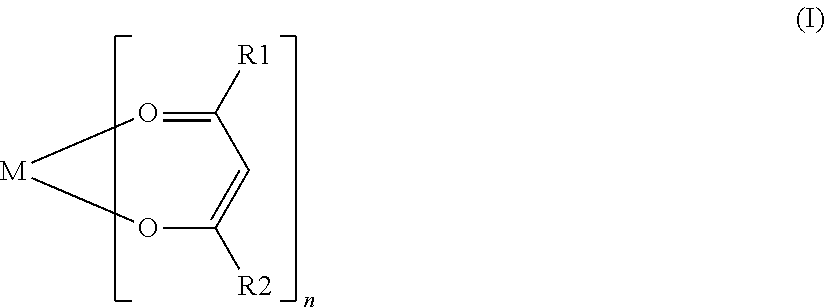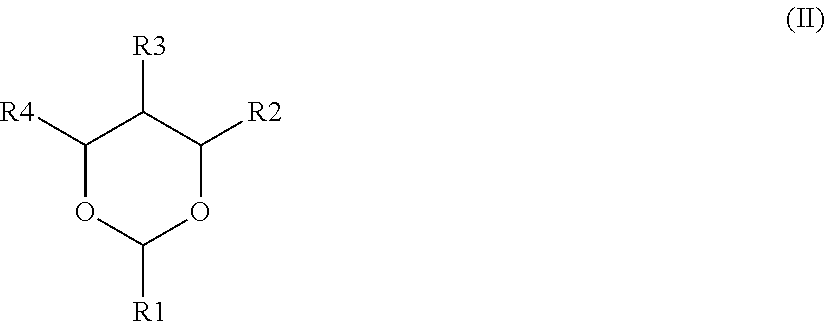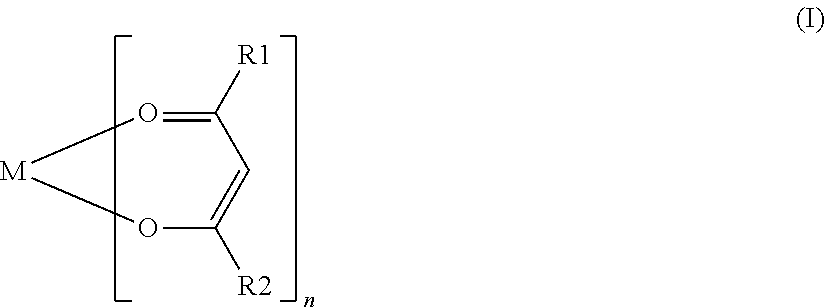Nonaqueous secondary battery
a secondary battery and non-aqueous technology, applied in the field of secondary batteries, can solve the problems of large amount of transition metals eluted from the active material of positive electrodes, and large resistance of positive electrodes, and achieve the effect of low cost and better results
- Summary
- Abstract
- Description
- Claims
- Application Information
AI Technical Summary
Benefits of technology
Problems solved by technology
Method used
Image
Examples
examples 1 to 15
, COMPARATIVE EXAMPLES 1 TO 10
[0051]In each nonaqueous secondary battery of Examples 1 to 15 and Comparative Examples 1 to 10, LiCoO2, having an average particle diameter of 13.1 μm and a specific surface area of 0.25 m2 / g, was used as a positive electrode active material. The added amount of each of the various DOX derivatives is shown below as the ratio to the total mass of a nonaqueous electrolyte, and the added amount of each of the various coupling agents is also shown as the ratio to the mass of the positive electrode active material.
[0052]In Comparative Example 1, the nonaqueous electrolyte contained no DOX derivative, and no coupling agent was added to the positive electrode mixture layer. In Comparative Examples 2 to 7, 1,3-dioxane as a DOX derivative with a varied concentration of 0.05 to 2.00% by mass was added to the nonaqueous electrolyte, while no coupling agent was added to the positive electrode mixture layer.
[0053]In Comparative Examples 8 and 9, no DOX derivative w...
examples 16 to 33
, COMPARATIVE EXAMPLES 11, AND 12
[0061]In each nonaqueous secondary battery of Examples 16 to 33, and Comparative Examples 11, and 12, LiCoO2, having an average particle diameter of 13.1 μm and a specific surface area of 0.25 m2 / g, was used as a positive electrode active material, and 1,3-dioxane was added as a DOX derivative to the nonaqueous electrolyte to have a concentration of 1.0% by mass.
[0062]In Comparative Example 11, ferric trisacetylacetonate was used as a coupling agent. In Examples 16 to 21, various compounds represented by General Formula (I) were used as a coupling agent, and in Examples 22 to 26, various silane coupling agents were used. Each of the coupling agents used in Examples 16 to 21 was a compound having an alkoxy group except for aluminum trisacetylacetonate used in Example 18 and zirconium tetrakisacetylacetonate used in Example 21. The names of the various coupling agents used in Examples 16 to 21 are listed in Table 2.
(where M is one atom selected from Al...
examples 34 to 46
, AND COMPARATIVE EXAMPLES 13 TO 31
[0068]In each nonaqueous secondary battery of Examples 34 to 46, and Comparative Examples 13 to 31, 1,3-dioxane was added as a DOX derivative to the nonaqueous electrolyte, and aluminum bisethylacetoacetate monoacetylacetonate was added to the positive electrode mixture layer as a coupling agent.
[0069]In Examples 34 to 42, and Comparative Examples 13 to 26, LiCoO2 having a varied average particle diameter of 3.3 to 16.4 μm and a varied specific surface area of 0.11 to 0.90 m2 / g was used as the positive electrode active material, and 1,3-dioxane and a coupling agent were or were not added. In Examples 43 to 46, and Comparative Examples 27 to 30, various positive electrode active materials other than LiCoO2 were used, and 1,3-dioxane and a coupling agent were or were not added.
[0070]In Examples 34 to 46, and Comparative Examples 13 to 30, when 1,3-dioxane was added to the nonaqueous electrolyte, 1,3-dioxane was added so as to have a concentration of ...
PUM
| Property | Measurement | Unit |
|---|---|---|
| specific surface area | aaaaa | aaaaa |
| particle diameter | aaaaa | aaaaa |
| particle diameter | aaaaa | aaaaa |
Abstract
Description
Claims
Application Information
 Login to View More
Login to View More - R&D
- Intellectual Property
- Life Sciences
- Materials
- Tech Scout
- Unparalleled Data Quality
- Higher Quality Content
- 60% Fewer Hallucinations
Browse by: Latest US Patents, China's latest patents, Technical Efficacy Thesaurus, Application Domain, Technology Topic, Popular Technical Reports.
© 2025 PatSnap. All rights reserved.Legal|Privacy policy|Modern Slavery Act Transparency Statement|Sitemap|About US| Contact US: help@patsnap.com



